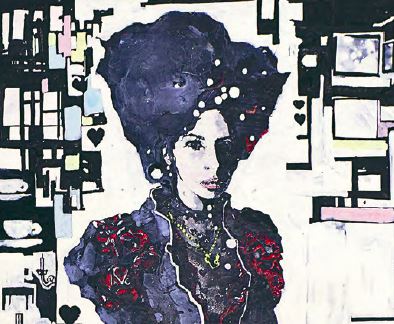 |
| Central European cards |
In A Red & Pleasant Land, Zak S. has obviously used the four aforementioned suits, what with the Alice in Wonderland connection. The four suits feature prominently in Chapter III, Beasts & People, because of the various Orders named after the suits in the employ of the Heart Queen.
However, given the prevalent Mitteleuropean milieu of the setting, I think it would have been nice to introduce Central European suits, and also to expand upon their possible use with the game. This is what I am going to attempt here.
First, a word about playing cards— They were introduced from Mamluk Egypt to Europe via Italy in the 14th century. Italian playing cards (used to this day) have retained the original Mamluk suits of swords, cups, coins, and staves. In the mid-15th century, in Central Europe, these suits became leaves, hearts, bells, and acorns. At the end of the 15th century, the French derived the presently-known suits from the Central European ones.
Playing cards have, since the very beginning, piqued the interest of occultists and diviners, who have devised all manners of correspondences between the suits and various elements of European life, e.g.:
| Suit | Social Class | Season | Element | Divination |
|---|---|---|---|---|
| Leaves | Burghers | Autumn | Air | Hope |
| Hearts | Clergy | Spring | Water | Love |
| Bells | Nobility | Summer | Earth | Money |
| Acorns | Peasants | Winter | Fire | Trouble |
Another difference between French playing cards and Central European decks is in the area of face cards. Whereas French cards sport the well-known Jack, Queen, and King, Central European cards have three male face cards per suit: Unter (a lower-class knave), Ober (an upper-class knave), and König (King). Aces are also slightly different, as each ace in a Central European deck depicts one of the seasons of the year.
 |
| Bells, Acorns, and Leaves cards. |
So how would the use of Central European cards impact A Red & Pleasant Land?
First of all, both French and Central European cards use Hearts as one of the suits, so at least there wouldn't be any change in this respect, and the Heart Queen would remain the Heart Queen (but see below).
The orders would be modified as follows:
✠ The Order of Clubs (soldiers) becomes the Order of Acorns
✠ The Order of Diamonds (courtiers) becomes the Order of Bells
✠ The Order of Spades (commoners) becomes the Order of Leaves
Another impact would be a reduced number in monarchs: instead of six decapitated lords, 3 kings and 3 queens, there are only three– the three Kings of Bells, Acorns, and Leaves.
As for Hearts, instead of having a timid king and a queen, the use of Central European playing cards would imply:
✠ The Queen of Hearts, female counterpart to the King of Hearts (works as the Heart Queen described in A Red & Pleasant Land) except that she's naturally the top ruler of Hearts
✠ The Ober of Hearts — use the King of Hearts described in the book in his role as the general of the Hearts' army
✠ The Unter of Hearts — use the Knave of Hearts as described in the book
Should you be able to get hold of a Central European deck of cards, you could use them along with the 'correspondences' table above to ad-lib the effects of spells (via the elements or the divination column), to randomly generate NPCs, etc. You may also add the following (even though I prefer not to use demi-humans in a faux European setting):
| Suit | Class | Race |
|---|---|---|
| Leaves | Magic-User | Elf |
| Hearts | Cleric | Human |
| Bells | Fighter | Dwarf |
| Acorns | Specialist | Halfling |




